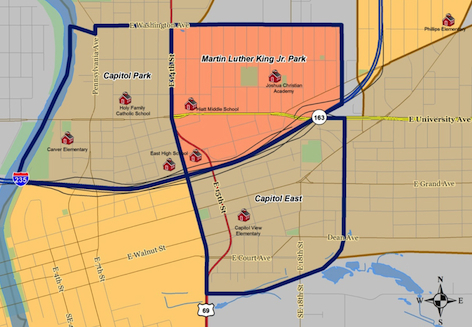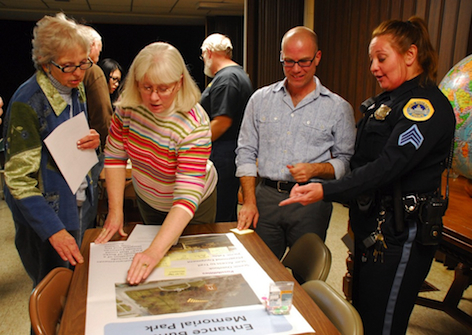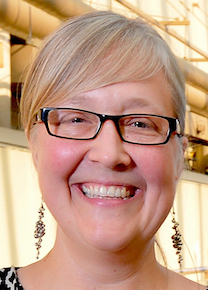
Des Moines East Bank neighborhoods: Capitol Park, Martin Luther King Jr. and Capitol East.
AMES, Iowa — Graduate students in an Iowa State University community and regional planning studio have been helping two of Des Moines' oldest and most diverse neighborhoods — Capitol East and Capitol Park — plan for their next two decades of change.
Students in Assistant Professor Jane Rongerude's class have worked on hands-on projects with the Des Moines Neighborhood Development Division for the past two years. Last fall they teamed up again with Des Moines neighborhood planner and ISU alumna Amber Lynch.
"While I was at Iowa State, we did a downtown plan for the city of Waukee, and that opportunity to work on a real project was an invaluable part of my experience," Lynch said. "I've always felt strongly about creating those opportunities for students if I can."
Students bring a unique perspective to the planning process as they have the time and ability to research best practices and discover innovative solutions, Lynch said.
“They’re plugged into the most contemporary thinking, so they bring ideas that neighborhood planners may not be looking at,” Rongerude said.
The students will present the plans to the neighborhood associations on Feb. 12 and 13 respectively (location to come). It's the first round of presentations in a two-month approval process with the plan and zoning commission, city council and county board of supervisors. Once approved, the plans will become part of the city's comprehensive plan.
Common concerns
The two neighborhoods share rapidly shifting demographics — more than 40 percent of Capitol Park’s population and more than 30 percent of Capitol East’s is Latino. In both, more than a third of residents are younger than 18, and average household incomes are less than half of those for Des Moines as a whole. Both also face issues of aging infrastructure, affordable housing, crime and population decline.
“Essentially, they’re concerned about being competitive with the suburbs, attracting new families and providing more opportunities while preserving a sense of identity and community,” Rongerude said.
Two groups of seven students helped the Capitol East and Capitol Park neighborhood associations identify the achievements of their prior plans, their current concerns and goals for the new plans. They also brought together leaders of nonprofit and other organizations in Des Moines with city staff members to address specific issues identified.

Community and regional planning grad student Jon Wolseth meeting with Capitol Park neighborhood residents. Photo by Alison Weidemann.
Community engagement
The class devoted an average of 200 hours per week in each neighborhood to conduct personal interviews with residents and business owners, infrastructure and visual preference surveys, youth events, and outreach to the Latino community and African and Southeast Asian refugees.
They talked with people outside convenience stores, in churches and schools, at sporting events, and door to door. And they interacted with classes at East High School and conducted outreach programs on Spanish-language radio.
“I’m really proud that our approach has been so qualitative, which doesn’t often happen in the planning field because it’s incredibly labor intensive," said graduate student Jon Wolseth from Aurora, Colo. "On the other hand, how are you going to give life to some of the statistics you collect if you don’t animate them with human experience?”
Students in the class spoke Arabic, Chinese, Spanish and French — "a real benefit in reaching out to people who traditionally have not been a part of the planning process,” said Wolseth, the Capitol Park neighborhood engagement team leader.
“We were able to show that many residents have common concerns regardless of age or ethnicity and to identify particular needs and opportunities for different demographic groups,” he said.
Themes and strategies
The students analyzed field notes from these interactions together with demographic, housing, crime and traffic data collected from city, county and state offices. They then entered the data into GIS applications to do spatial mapping, which highlighted problem areas. They used this information to establish three focus themes for each neighborhood.
One of Capitol East’s chief concerns was infrastructure, while crime and safety was a key issue for Capitol Park. Both emphasized housing and youth programming. Underlying all was a desire to embrace the neighborhoods’ diversity and enhance opportunities for all residents to participate fully in the life of the community.
“Once we had extracted themes and generated strategies to solve some of the problems, we took these ideas to the steering committee meetings with people who have the power to make changes,” said Julie Whitson, a graduate student from St. Louis, Mo., and Capitol East steering committee team leader.
“We contacted nonprofit leaders, city personnel and people who knew about different resources and got them all in the room to discuss specific steps that we could actually implement,” she said.
Although programs already exist to address some neighborhood concerns, the students' research showed that many residents were unaware of or unable to access them. Cultural and linguistic barriers sometimes prevented participation. Many recommendations focused on community building and development of networks like a youth volunteer corps and a local business association; strengthening partnerships with city, county and nonprofit agency resources; and physical improvements to homes, sidewalks and streets.
“When you get the right organizations together with proposed solutions, you begin to get some buy-in and commitment,” Whitson said.
“We’ve identified strategies to connect different actors with each other. Success will depend on realizing these connections and building bonds that are fortified over time,” Wolseth said
